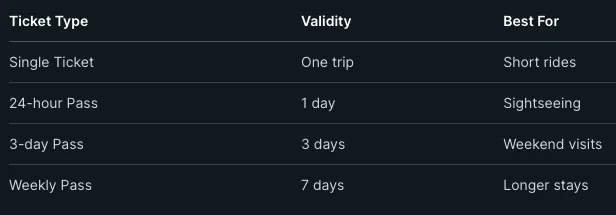Budapest Travel: Best Public Transport Options, Tips & Tricks
Skip the taxi traps! Discover Budapest’s best public transport options — from scenic trams to cheap metro passes — and travel the city like a local.

Budapest Travel: Best Public Transport Options, Tips & Tricks
Budapest blends old-world charm with a lively modern spirit. You can stroll past grand architecture, soak in centuries-old thermal baths, and enjoy affordable dining that rivals any major European city. Budapest offers a perfect mix of culture, relaxation, and adventure all in one place.

You can easily explore both sides of the city—Buda with its hills and castles, and Pest with its cafés and nightlife—thanks to one of Europe’s most efficient public transport networks. Whether you’re planning to cruise the Danube, unwind at Széchenyi Baths, or discover the city’s famous ruin bars, Budapest gives you plenty of ways to make the most of your trip.
Get ready to uncover practical tips, travel options, and simple ways to save time and money while exploring Hungary’s capital. With a bit of planning, you can enjoy an unforgettable experience in this beautiful and budget-friendly city.
Key Takeaways
- Learn how to get around Budapest easily and affordably
- Discover practical advice to make your trip smoother
- Find quick answers to common travel questions
Best Public Transport in Budapest
Budapest offers a reliable and easy-to-use public transport system that helps you move around the city efficiently. You can choose from the metro, trams, buses, trolleybuses, suburban trains, and even boats on the Danube. The system is run by the Budapest Transport Centre (BKK).
The metro is fast and simple to navigate. There are four lines (M1–M4) that connect major parts of the city. The M1, also called the Millennium Underground, is one of the oldest metro lines in Europe and a UNESCO World Heritage site.
Trams are a scenic way to travel, especially Tram 2, which runs along the Danube and offers views of landmarks like Parliament and Buda Castle. Frequent trams such as lines 4 and 6 run through the city centre all day and night. Learn more about tram routes on Budapestinfo.hu.
Buses and trolleybuses reach areas not covered by the metro or trams. Night buses operate after midnight, so you can still travel when other services stop.
For trips beyond the centre, the HÉV suburban railway connects Budapest with nearby towns like Szentendre and Gödöllő. You can also take public boats across the Danube in warmer months for a pleasant commute.

You can buy and validate tickets using the BudapestGO app, which provides real-time route planning and mobile ticketing, as described by Travel Hungary Now.
Options

You can move around Budapest easily thanks to its well-connected public transport system. The city offers buses, trams, trolleybuses, metro lines, and suburban trains that reach nearly every district. The network runs frequently during the day and provides reliable service late at night.
At night, trams operate on the Grand Boulevard, and night buses cover the rest of the city. Their routes start with the number 9, making them easy to identify. You can check schedules and maps at major stations or online at BKK.hu.
If you prefer more flexibility, you can use taxis, ride-hailing apps, or car rentals. Always ensure taxis are licensed and display official markings. For short distances, walking is often the fastest and most pleasant way to explore central areas.
Budapest also promotes micromobility. You can rent bikes or scooters through the city’s public bike-sharing service MOL Bubi. These options are ideal for reaching places that are less accessible by car or public transport.

Tips And Tricks
Carry some cash in Hungarian forints (HUF). Many small shops and cafés still prefer cash, even though cards are widely accepted. Avoid exchanging money at the airport, where rates are less favourable.
Use public transport to move around easily. The metro, trams, and buses are reliable and affordable. Tram 2 offers scenic views along the Danube, as noted by Our Wanders.
Validate your ticket before boarding. Ticket inspectors are strict, and fines are common if you forget. You can also buy a Budapest Card for unlimited travel and discounts at museums and baths.
Tipping is customary. Leave around 10–15% in restaurants and cafés, or round up the bill. Some places include a service charge, so check the receipt first, as mentioned by Lonely Planet.
Stay alert for tourist scams near major attractions. Be cautious of unofficial taxis and people offering to exchange money on the street.

Learn a few basic Hungarian phrases. Even simple greetings like “Szia” (hello) or “Köszönöm” (thank you) make a good impression with locals.
Frequently Asked Questions
Budapest offers a mix of historic landmarks, hearty food, and easy transport options. You can explore famous sights, taste authentic Hungarian dishes, and learn simple customs that help you connect with locals. Affordable stays and reliable public transport make visiting the city convenient for every traveller.
What are the top attractions to visit in Budapest?
You can visit Buda Castle, Fisherman’s Bastion, and St. Stephen’s Basilica for classic views and architecture. The Széchenyi Thermal Bath offers a relaxing experience in one of Europe’s largest spa complexes. For more sightseeing tips, explore the Budapest FAQ for detailed visitor information.
Can you recommend some traditional Hungarian dishes to try while in Budapest?
Try goulash, a beef soup seasoned with paprika, and lángos, a fried flatbread topped with sour cream and cheese. You can also enjoy chimney cake and stuffed cabbage at local markets or restaurants. The Visit Budapest travel tips site highlights more local food experiences.
What is the best time of year to visit Budapest for good weather?
Late spring (May–June) and early autumn (September–October) usually bring mild temperatures and fewer crowds. Summers can be hot, while winters are cold but festive with Christmas markets. The It’s Hungary travel guide explains how weather affects travel costs and activities.
How do I get around the city using public transport?
Budapest’s network of trams, buses, and metro lines is reliable and affordable. Always validate your ticket before boarding to avoid fines, as inspectors check regularly. For practical guidance, see Budapest transport safety tips and ticket options on Trip to Budapest.
Are there any cultural etiquettes I should be aware of when visiting Budapest?
Greet people with a handshake and maintain eye contact during conversations. Avoid clinking beer glasses, a local superstition dating back to the 19th century. Dress modestly when visiting churches or formal venues, and always say “köszönöm” (thank you) to show politeness.
What are the options for budget accommodation in Budapest?
You can find hostels, guesthouses, and affordable hotels across central districts like Erzsébetváros and Józsefváros. Many offer shared kitchens and free Wi-Fi. The Budapestinfo.hu FAQ lists helpful details about city passes and discounts that can make your stay cheaper.